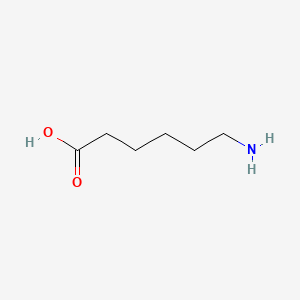| MeSH term | MeSH ID | Detail |
|---|---|---|
| Hypotension | D007022 | 41 associated lipids |
| Acute Kidney Injury | D058186 | 34 associated lipids |
| Heart Failure | D006333 | 36 associated lipids |
| Pulmonary Edema | D011654 | 23 associated lipids |
| Pulmonary Embolism | D011655 | 5 associated lipids |
| Hydronephrosis | D006869 | 4 associated lipids |
| Nerve Compression Syndromes | D009408 | 4 associated lipids |
| Corneal Diseases | D003316 | 13 associated lipids |
| Prostatic Neoplasms | D011471 | 126 associated lipids |
| Heart Diseases | D006331 | 8 associated lipids |
6-aminohexanoic acid
6-aminohexanoic acid is a lipid of Fatty Acyls (FA) class. 6-aminohexanoic acid is associated with abnormalities such as Blood Clot, Myocardial Infarction, Cerebrovascular accident, Renal impairment and Scoliosis, unspecified. The involved functions are known as Fibrinolysis, Agent, Hemorrhage, plasminogen activation and inhibitors. 6-aminohexanoic acid often locates in Chest, Blood, Body tissue, peritoneal and Plasma membrane. The associated genes with 6-aminohexanoic acid are P4HTM gene, BSND gene, MTPN gene, NDUFS4 gene and Homologous Gene. The related lipids are Phosphatidylserines and Butyric Acid.
Cross Reference
Introduction
To understand associated biological information of 6-aminohexanoic acid, we collected biological information of abnormalities, associated pathways, cellular/molecular locations, biological functions, related genes/proteins, lipids and common seen animal/experimental models with organized paragraphs from literatures.
What diseases are associated with 6-aminohexanoic acid?
6-aminohexanoic acid is suspected in Cerebrovascular accident, Blood Clot, Myocardial Infarction, Renal impairment, Thromboembolism, Postoperative myocardial infarction and other diseases in descending order of the highest number of associated sentences.
Related references are mostly published in these journals:
| Disease | Cross reference | Weighted score | Related literature |
|---|
Possible diseases from mapped MeSH terms on references
We collected disease MeSH terms mapped to the references associated with 6-aminohexanoic acid
PubChem Associated disorders and diseases
What pathways are associated with 6-aminohexanoic acid
There are no associated biomedical information in the current reference collection.
PubChem Biomolecular Interactions and Pathways
Link to PubChem Biomolecular Interactions and PathwaysWhat cellular locations are associated with 6-aminohexanoic acid?
Visualization in cellular structure
Associated locations are in red color. Not associated locations are in black.
Related references are published most in these journals:
| Location | Cross reference | Weighted score | Related literatures |
|---|
What functions are associated with 6-aminohexanoic acid?
Related references are published most in these journals:
| Function | Cross reference | Weighted score | Related literatures |
|---|
What lipids are associated with 6-aminohexanoic acid?
Related references are published most in these journals:
| Lipid concept | Cross reference | Weighted score | Related literatures |
|---|
What genes are associated with 6-aminohexanoic acid?
Related references are published most in these journals:
| Gene | Cross reference | Weighted score | Related literatures |
|---|
What common seen animal models are associated with 6-aminohexanoic acid?
There are no associated biomedical information in the current reference collection.
NCBI Entrez Crosslinks
All references with 6-aminohexanoic acid
Download all related citations| Authors | Title | Published | Journal | PubMed Link |
|---|---|---|---|---|
| Schuette AJ et al. | An examination of aneurysm rerupture rates with epsilon aminocaproic acid. | 2013 | Neurocrit Care | pmid:22847395 |
| Meybohm P et al. | Aprotinin may increase mortality in low and intermediate risk but not in high risk cardiac surgical patients compared to tranexamic acid and ε-aminocaproic acid -- a meta-analysis of randomised and observational trials of over 30.000 patients. | 2013 | PLoS ONE | pmid:23483965 |
| Chen CY et al. | pH-dependent, thermosensitive polymeric nanocarriers for drug delivery to solid tumors. | 2013 | Biomaterials | pmid:23498892 |
| Kostousov V et al. | Influence of resuscitation fluids, fresh frozen plasma and antifibrinolytics on fibrinolysis in a thrombelastography-based, in-vitro, whole-blood model. | 2013 | Blood Coagul. Fibrinolysis | pmid:23406662 |
| Ortmann E et al. | Antifibrinolytic agents in current anaesthetic practice. | 2013 | Br J Anaesth | pmid:23661406 |
| Frank MM | Update on preventive therapy (prophylaxis) for hereditary angioedema. | 2013 | Immunol Allergy Clin North Am | pmid:24176214 |
| Bouziotis P et al. | Radiochemical and radiobiological assessment of a pyridyl-S-cysteine functionalized bombesin derivative labeled with the (99m)Tc(CO)3(+) core. | 2013 | Bioorg. Med. Chem. | pmid:24035515 |
| Makhija N et al. | Comparison of epsilon aminocaproic acid and tranexamic Acid in thoracic aortic surgery: clinical efficacy and safety. | 2013 | J. Cardiothorac. Vasc. Anesth. | pmid:24050855 |
| Baharoglu MI et al. | Antifibrinolytic therapy for aneurysmal subarachnoid haemorrhage. | 2013 | Cochrane Database Syst Rev | pmid:23990381 |
| Cohen HV et al. | Platelets and bleeding in the dental patient. It's not always from "blood thinners". Von Willebrand disease--clinical assessment and case report. | 2013 | J N J Dent Assoc | pmid:23991505 |
